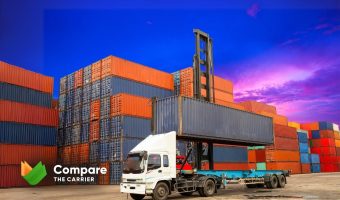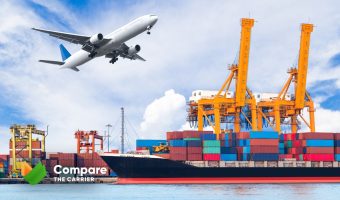In the fast-paced world of global trade, understanding the nuances of port container transport is crucial. This article sheds light on the intricate dance of container shipping, offering insights into the meticulous process that moves goods across oceans and continents. From the bustling ports to the open seas, we explore the ins and outs of container move and logistics, emphasizing the vital role of choosing the right carrier. With Compare The Carrier, you’re not just shipping; you’re revolutionizing the way you move your cargo.
Navigating the Seas of Container Shipping: Understanding the Basics

Container shipping stands as the linchpin of global commerce, a fascinating world where efficiency and coordination are paramount. This intricate network, spanning oceans and continents, hinges on the seamless interplay of port container transport, container logistics, and the art of container move. Let’s delve into the essentials of this dynamic domain, crucial for anyone involved in the vast tapestry of international trade.
Defining Container Shipping
At its core, container shipping is about moving goods in standardized, secure containers across the seas. This method has revolutionized how we conduct global trade, offering a harmonious blend of security, efficiency, and cost-effectiveness. It’s not just about the containers themselves, which range from standard sizes like 20-foot and 40-foot units to specialized types for unique cargo needs, but about the system that moves them.
The Heartbeat of Trade: Port Container Transport
Ports serve as the critical nodes in this logistics network, acting as the transition points between sea and land transport. The efficiency of port logistics is a cornerstone in ensuring the smooth flow of goods, highlighting the importance of adept handling and storage of containers. These hubs are where the pulse of global commerce is most palpable, equipped with cranes, automated systems, and sophisticated strategies for managing the ebb and flow of trade.
The Dance of Container Logistics
The journey of a container doesn’t end at the port. It involves a complex ballet of transportation modes, including rail and trucking, to reach its final destination. This segment of the journey is where container move becomes a symphony of coordination, demanding precise timing and synchronization across various players in the supply chain. Furthermore, navigating the sea of documentation and compliance with international shipping regulations is a critical aspect, ensuring a smooth voyage from start to finish.
In essence, container shipping, and the logistics that power it, are the engines driving the world’s economy. From the bustling ports handling endless streams of containers to the intricate logistics orchestrating their journey, this is a realm where precision, efficiency, and global connectivity converge.
The Heart of the Action: Ports and Their Function

Ports are where the action happens in the world of container shipping. They are not just places where ships dock and unload but are critical centers for global trade and logistics. In this section, we explore the vital role of ports in port container transport and container logistics, focusing on their function and the importance of efficient operations.
An Overview of Port Logistics
Port logistics are the backbone of efficient container shipping. This involves the management of various activities such as loading and unloading of containers, storage, freight forwarding, and customs clearance. Ports act as crucial nodes in the supply chain, connecting sea transport with land-based logistics like trucking and rail. The efficiency of these operations directly impacts the speed and cost of container move and, by extension, the entire global trade mechanism.
Key elements of port logistics include:
The Importance of Efficient Port Operations
Efficient port operations are essential for the smooth functioning of international trade. Ports that can quickly process ships and manage cargo effectively contribute significantly to reducing overall shipping times and costs. This is particularly crucial in the context of port container transport, where delays can have a domino effect on the entire supply chain.
Factors contributing to efficient port operations include:
Efficient port logistics not only streamline container shipping but also play a pivotal role in enhancing the competitiveness of businesses relying on international trade. As the hubs where maritime meets land, ports are more than transit points; they are integral to the global economic landscape, making their role in container logistics indispensable.
In conclusion, ports, through their sophisticated operations and strategic management, are the heartbeats of container logistics. The effectiveness of port container transport hinges on how well these maritime gateways function, underlining the importance of continuous improvement and innovation in port operations.
Optimizing Container Movement: Strategies for Efficient Handling and Transport
Optimizing container movement in the world of container logistics involves a blend of strategic planning, technological innovation, and seamless coordination. Here are key strategies for enhancing efficiency in port container transport and container shipping:

By implementing these strategies, businesses and stakeholders in the container shipping industry can significantly enhance the efficiency of container moves, ensuring smoother, faster, and more cost-effective transport solutions.
Real-world success stories: Learning from the best
In the dynamic world of port container transport and container logistics, learning from successful examples provides invaluable insights. Here, we explore some real-world success stories that have set benchmarks in container shipping and port logistics, showcasing innovative strategies and best practices.
A Model of Efficiency: Known as Europe’s largest port, the Port of Rotterdam stands as a paragon of port logistics excellence. This port has embraced digital transformation to optimize container move processes. With a state-of-the-art automated terminal and advanced container tracking systems, the Port of Rotterdam demonstrates how technology can revolutionize port operations.
Harnessing Technology for Superior Logistics: The Port of Singapore, one of the busiest in the world, exemplifies the successful integration of technology in port container transport. By utilizing automated cranes and AI-driven predictive analytics, this port has significantly enhanced its container handling efficiency, setting new standards in container logistics.
Maersk‘s Digital Innovation
Global shipping giant Maersk has been at the forefront of integrating digital solutions in container shipping. Their use of blockchain technology to manage shipping documentation has not only streamlined operations but also introduced unprecedented levels of transparency and security in the logistics chain.
Hamburg Port Authority’s SmartPORT Logistics
Hamburg’s approach to port logistics involves the innovative use of smart technologies. The SmartPORT logistics initiative leverages IoT and big data to optimize traffic and container movement, significantly reducing waiting times and improving overall port efficiency.
These examples underscore the importance of embracing innovation and strategic planning in container logistics. By learning from these pioneers, companies engaged in port container transport and container shipping can enhance their operations, leading to more efficient, secure, and sustainable logistics solutions.
Emerging Technologies in Container Logistics

The landscape of container logistics is rapidly evolving, thanks in large part to advancements in technology. Emerging technologies like Artificial Intelligence (AI), the Internet of Things (IoT), and blockchain are playing pivotal roles in transforming port container transport, container shipping, and the broader field of container move and logistics. Let’s explore how these technologies are reshaping the industry:
These technologies are not just futuristic concepts; they are currently being implemented and are showing tangible benefits in the field of container logistics. By embracing AI, IoT, and blockchain, the industry is moving towards a more efficient, transparent, and secure future in container shipping and port operations.
In conclusion, the world of port container transport and container logistics is intricate yet vital to the global economy. From the efficient operation of ports to the strategic movement of containers, every aspect plays a critical role in the smooth functioning of international trade. The adoption of emerging technologies like AI, IoT, and blockchain is setting new benchmarks in efficiency, transparency, and security.
As we’ve explored through various aspects and real-world examples, the key to successful container shipping lies in understanding and leveraging these dynamic components. Whether you’re a business involved in global trade or an individual interested in the logistics industry, recognizing the nuances of container transport is essential. With services like Compare The Carrier, navigating this complex world becomes more accessible, offering tailored solutions that cater to the evolving needs of container logistics.
FAQ
What are the key challenges in container move operations?
Key challenges include managing logistical complexities, ensuring timely deliveries, handling customs and regulatory compliance, and coordinating among various stakeholders.
How important is container logistics in supply chain management?
Container logistics is crucial in supply chain management as it ensures the efficient transport and handling of goods, impacting overall supply chain performance and reliability.
What technologies are transforming port logistics?
Technologies like AI for predictive analytics, IoT for real-time tracking, and blockchain for secure documentation are significantly transforming port logistics.
Can small businesses benefit from professional container shipping services?
Absolutely. Professional container shipping services provide scalable solutions that can greatly assist small businesses in expanding their reach and efficiently managing international trade.
What is the role of a port authority in container transport?
A port authority manages and regulates the operations of a port, ensuring efficient handling, safety, and compliance with maritime laws, crucial for smooth container transport.
How does weather impact container shipping?
Weather conditions can significantly impact container shipping, causing delays and route changes due to rough seas, port closures, and safety considerations.










